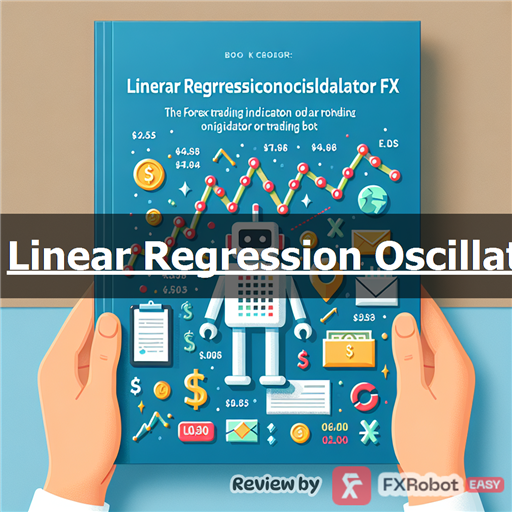At this time, purchasing EASY Bot items is not available to all members. Read more - how to get access to purchase
Linear Regression Oscillator FX
Easy Rating: 0/0
MQL Rating: 0/0


Overview
So you’ve stumbled upon the Linear Regression Oscillator FX—sounds fancy, right? It’s like that statistician friend who insists on drawing the perfect line through your chaotic price data. But can this math wizard truly tell you when to buy low and sell high? Or is it just another indicator that looks good in theory but sound asleep in practice? Let’s roll up our sleeves and dissect this gizmo, with a wink and a nod, because trading on Forex ain’t exactly a stroll in the park—and neither is picking the right tool for the job.
📈 What Exactly Is the Linear Regression Oscillator FX?
The Linear Regression Oscillator FX hinges on a simple yet powerful concept: it quantifies the difference between the current price and a predicted baseline given by the linear regression line. This best-fit line is not just any average; it represents the statistically derived expected price movement over a set period, smoothing out random noise to unveil the underlying trend direction with remarkable clarity 📊. What makes this oscillator particularly valuable is its ability to reflect momentum shifts by oscillating around a zero line — positive values indicate the price is above the regression line (potentially overbought), while negative values signal it’s below (potentially oversold). This gives traders an immediate, visual cue on price deviations that often precede reversals or trend accelerations.
It’s important to highlight that the effectiveness of this technical indicator depends heavily on parameter settings like the look-back period and deviation thresholds, which must be fine-tuned according to market conditions and trading style. Unlike some lagging indicators that react sluggishly, the Linear Regression Oscillator strives to strike a balance between sensitivity and noise reduction, which is crucial in fast-moving Forex or cryptocurrency environments 🚀. Leveraging such an indicator can aid in spotting mean reversion opportunities or confirming trend persistence. However, this sophistication comes with a caution: overfitting the settings or misunderstanding the linear regression principles can lead to false signals, emphasizing the need for experiential judgment and risk management strategies in any trading approach. For traders targeting precise entry points, this indicator offers a quantifiable edge but should never be solely relied upon without complementary analysis methods such as volume assessment or volatility filters⚖️.
🔍 The Nuts and Bolts: How Does It Work Under the Hood?
Peeling back the layers of the Linear Regression Oscillator FX reveals an intricate blend of statistical rigor and practical trading signals. At its core is the customizable look-back period, which determines the slice of historical price data used to calculate the linear regression line. This flexibility lets traders tailor the oscillator’s sensitivity—shorter periods react faster to price changes but risk noise, while longer periods smooth out fluctuations but can lag in capturing quick momentum shifts. The oscillator then quantifies the price deviation from this line, generating a series of values oscillating around zero that visually reflect the market’s momentum polarity 📉📈.
Beyond the core calculation, the system integrates defined overbought and oversold thresholds to flag potential mean reversion points where price may snap back toward the regression line. Trend changes are signaled when the oscillator crosses the zero-line, indicating a shift in momentum direction. To avoid false signals, invalidation levels act as failsafes, canceling edges when market conditions become ambiguous or volatile. These interlocking components allow LRO to deliver actionable signals, although they demand careful adjustment and confirmation with other tools like volatility indicators or trend filters to be truly effective in a live Forex or crypto environment. Traders familiar with sophisticated synthetic indicators, such as the EASY Trendopedia Bot or EASY Scalperology Bot, will recognize the importance of harmonizing signal sensitivity with noise reduction, a balancing act essential for consistent success in algorithmic trading 🎯📊.
🧐 Critical Look: Is the Developer’s Pitch on Point?
While the developer presents the Linear Regression Oscillator FX as a reliable gauge of momentum and trend direction, a critical eye reveals some limitations that traders must consider before fully trusting these claims. The indicator’s core premise—that the distance between price and the linear regression line maps momentum—is theoretically sound, yet its practical translation into actionable signals is vulnerable to market noise and false breakouts. Responsiveness to sudden price movements is a double-edged sword: tweaking the look-back period for agility can result in erratic signals that muddy the true trend picture, while over-smoothing dulls the oscillator’s edge, potentially missing early trend changes 🚦. This balancing act between sensitivity and stability is a familiar challenge among algorithmic trading tools, where overly optimistic developers sometimes oversell ideal performance without emphasizing these trade-offs.
Moreover, in comparing the LRO FX to proven trend-following models such as the EASY Trendopedia Bot or the EASY Breakopedia Bot, it becomes clear that the oscillator functions best as a supplementary tool rather than a standalone strategy. Leading systems often combine regression-based calculations with adaptive filters and risk management protocols to guard against whipsaws and false entries. The absence of detailed user reviews about real-world effectiveness only adds to the uncertainty around the system’s robustness. For traders seeking an indicator that voices clear, trustworthy signals in volatile markets, the LRO FX’s promises require measured skepticism and integration with broader algorithmic frameworks to mitigate inherent limitations 🔄📉.
📊 User Buzz: What Do Traders Really Say?
In the case of the Linear Regression Oscillator FX, an intriguing silence surrounds user feedback and community discussions. The absence of public reviews or comments might signal a few scenarios: either the tool has not yet gained widespread attention, or traders remain cautious before endorsing its practicality, given that the algorithmic trading landscape demands proven reliability. This void presents a unique opportunity for early adopters and seasoned professionals alike to share their firsthand experiences and contribute to shaping an informed, collective understanding of the oscillator’s real-world performance 📉🤔.
Such community-driven feedback is invaluable, especially when traders seek transparency about indicator effectiveness through authentic testimonials rather than manufacturer claims. As this trading system becomes tested in diverse market conditions, voices from users who apply it alongside other tools like volatility indicators or risk management strategies will help clarify its true edge. We encourage prospective users to join this dialogue, because in Forex and crypto markets, crowd wisdom and rigorous self-evaluation often distinguish fleeting hype from sustainable trading advantage 📈💬.
⚔️ Face-Off: How Does LRO Compare Against Other Trend-Based Systems?
When stacking the Linear Regression Oscillator FX against top-tier trend-based systems like EASY Trendopedia, EASY Scalperology, and EASY Breakopedia, distinct differences and parallels emerge. The LRO hinges on pure linear regression analysis, emphasizing statistical deviations from a trend line to gauge momentum changes. In contrast, the EASY Bots blend regression insights with artificial intelligence layers, adaptive filters, and dynamic risk management that elevates signal accuracy and reduces whipsaws in volatile Forex or crypto markets. This integration optimizes trade entries and exits with higher precision, a feature LRO in its basic form does not inherently possess 🚀📉.
While the LRO offers a transparent, mathematically grounded signal appealing to traders favoring classical statistical indicators, it tends to lag behind in handling complex market noise and sudden volatility surges. EASY Scalperology and EASY Breakopedia, for instance, combine multi-timeframe analysis and machine learning elements to adaptively filter false signals and enhance trend detection in real time. Traders looking for a ready-to-use algorithmic solution with robust backtesting and proven consistency might find these EASY Bots more suited to demanding trading environments 📊⚖️. However, the LRO FX can still serve as an insightful supplementary tool for those seeking refined momentum oscillator features without layering complex AI parameters, making it a useful part of a diversified trading strategy toolkit.
💡 Final Verdict: Should Traders Bet on Linear Regression Oscillator FX?
The Linear Regression Oscillator FX offers a theoretically sound approach to detecting momentum and trend shifts, but the lack of user feedback and its modest track record should raise caution flags for traders. Its price point is reasonable, yet without real-world validation from the community, it remains largely unproven in active trading environments dominated by noise and unpredictable swings. Relying solely on this indicator expecting foolproof signals could lead to frustration and unexpected losses, especially for those neglecting comprehensive risk management or complementary analytics 💡⚠️.
Author credibility and the transparent statistical foundation of the tool lend it some weight, but the lack of adaptive features and layered filters seen in advanced algorithmic trading systems limit its standalone effectiveness. For serious Forex or crypto traders, integrating the LRO with multi-dimensional tools like volatility analysis or trend filters is essential to enhance precision and reduce false entries. Ultimately, it’s a modestly useful tool for traders who appreciate technical rigor but must beware of overestimating its independent power in real market conditions 🚀📊.
🤝 From the FxRobotEasy Team: Our Take and Your Invitation
As the FxRobotEasy Team, we bring years of experience in developing and critically evaluating trading robots and technical indicators. Our journey includes crafting the acclaimed EASY Bot series, known for combining AI-driven algorithms with reliable trend-based logic, and maintaining honest broker ratings to protect traders worldwide. With the Linear Regression Oscillator FX, we see a technically intriguing tool grounded in statistical analysis but caution users to consider its place as part of a diversified strategy rather than a magic bullet. We strongly encourage traders to engage actively by testing it with demo accounts and sharing their observations to foster a transparent and knowledgeable trading community 🤝📈.
To facilitate this, we offer free sample code downloads of the Linear Regression Oscillator FX, enabling you to customize and backtest its parameters alongside other popular indicators. Collaboration and shared insights are vital in refining algorithmic trading systems in the dynamic Forex and crypto arenas. Remember, robust risk management and continuous performance review are the bedrock of long-term success, not any single technical solution. We stand ready to support and listen to your feedback, helping shape the future of smart, data-driven trading tools 📊⚡️.

Still looking for a profitable robot? Don't miss out on innovative EASY Bots! Join to get tutorials, transparent statistics, test versions and see how we turn algo trading into real income.
-
AI strategy: low risk, high return
-
Continuous optimisation and fine-tuning of algorithms
-
Powerful backend infrastructure
-
Forex/Crypto/Metall support
-
Free version of trading robot
-
Installation in MT5 in a couple of clicks

forexroboteasy.com



















